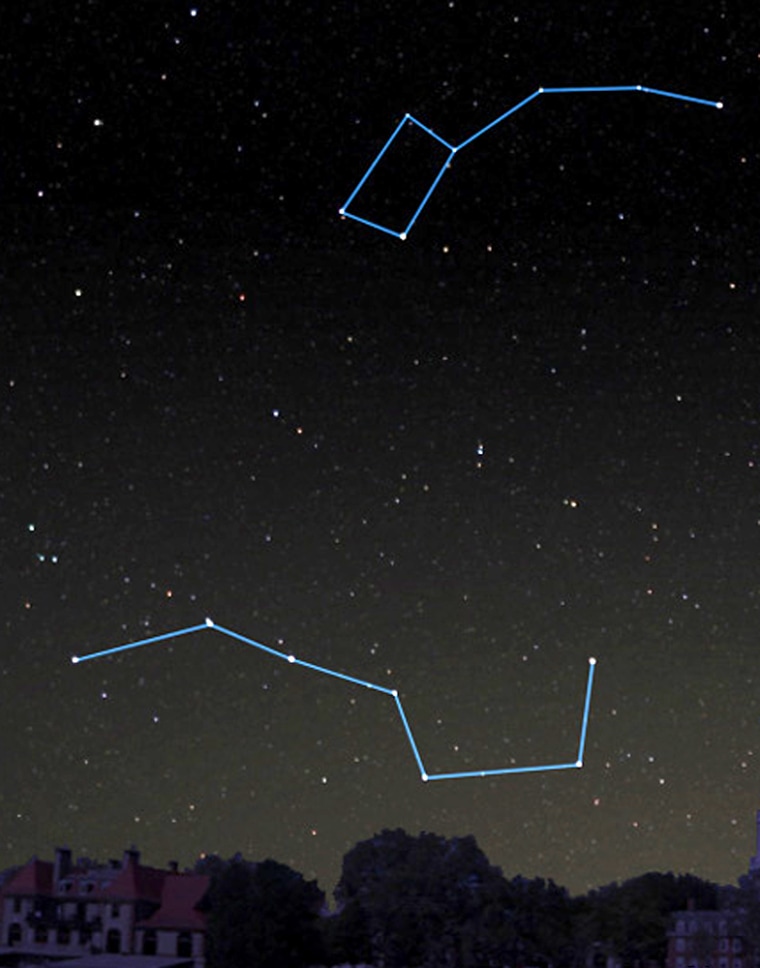This week, at around 8 p.m. local time, the Big Dipper — probably the best known star pattern — begins to pass under the north pole of the sky.
If you live at or near latitude 30 degrees north (Tallahassee, New Orleans, Houston) the lower half of the Dipper's bowl is now in the process of descending below the horizon. Farther south, down to 25 degrees latitude (the Florida Keys) the entire Dipper is sinking completely out of sight.
But if you're located anywhere north of 35 degrees latitude, it's well worth finding a clear and unobstructed northern horizon to catch the familiar Dipper at its most impressive: bowl side up and apparently looking much larger than normal, thanks to the so-called "moon illusion."
Actually, the sun and moon, as well as the constellations, always look much larger near the horizon than when they're high up. Yet, when measured or photographed, all celestial objects have exactly the same angular size, whether high or low in the sky. We humans have more experience in judging the size of objects when looking ahead than looking straight up, and things seen overhead seem smaller to us than when seen at the same distance horizontally.
If the Big Dipper is too low for you to see, the Little Dipper is still visible (unless you're near the equator). And its current orientation is such that it seems to be pouring its contents into its larger companion.
Of the two, the Little Dipper seems to more closely resemble a soup ladle, although the late Kenneth Franklin, former chief astronomer of New York's Hayden Planetarium, used to tell his audiences that the Little Dipper looked more like a meat cleaver.
Other dippers in the sky
There are actually a few other dippers that are visible in our early evening sky. A really big dipper is approaching the meridian high toward the south. It's composed of the main stars of Pegasus the Flying Horse, and Andromeda the Princess. The Great Square of Pegasus makes up the bowl, while the brightest stars from Andromeda form the handle. If you want to extend the handle, then throw in Mirfak, the brightest star of Perseus the Hero.
Slideshow 12 photos
Month in Space: January 2014
Those who live in the Southern Hemisphere are well-acquainted with an arrangement of four bright stars that closely resemble the famous Southern Cross, known as the "False Cross." So why not call this Pegasus/Andromeda/Perseus arrangement the "False Dipper"?
Another dipper can be found as darkness falls, low in the south-southwest in the constellation of Sagittarius the Archer: a star pattern that was much more popular in the star guides of former years — the "Milk Dipper." It's composed of some of the stars from the currently popular pattern known as the Teapot, plus one other star (Mu Sagittarii) above the lid of the Teapot. The Milk Dipper apparently got its name from the fact that it appears to be dipping into brightest part of the Milky Way.
And last, but by no means least, we have what some will mistake for the Little Dipper: the Pleiades star cluster. The main stars of this group indeed resemble a tiny skewed dipper, which is now rising in east-northeast sky, heralding the impending arrival of the brilliant stars of the winter season.

